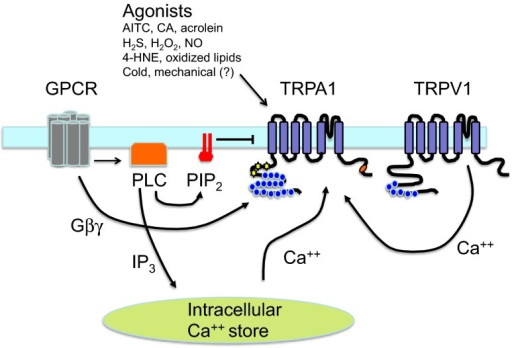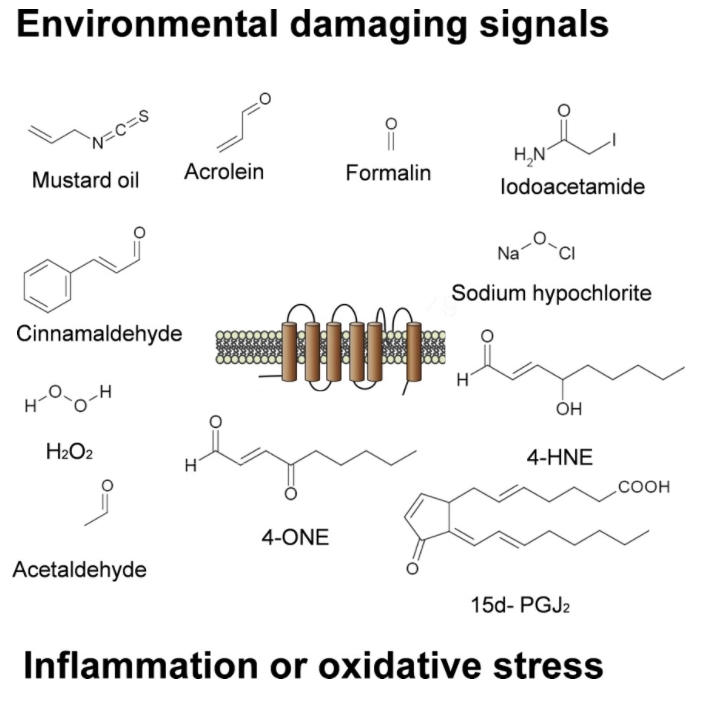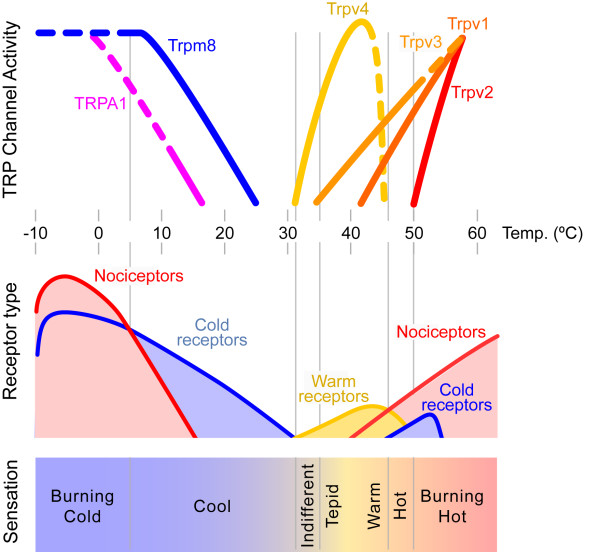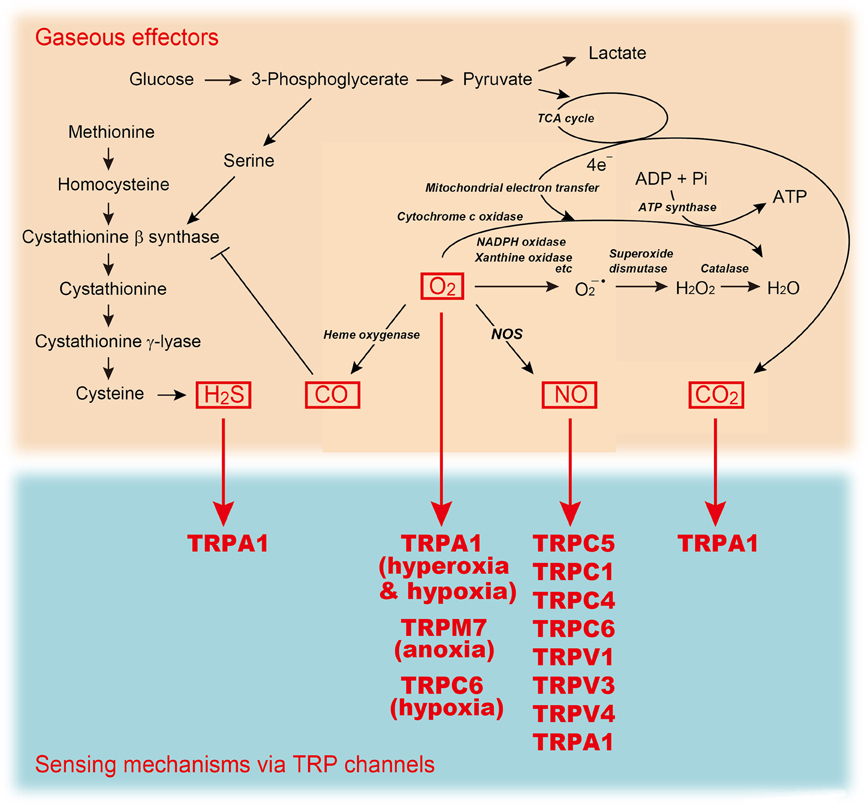| Hint | Food | 맛과향 | Diet | Health | 불량지식 | 자연과학 | My Book | 유튜브 | Frims | 원 료 | 제 품 | Update | Site |
|
식품 ≫ 기호성 ≫ 맛의 종류 Cold pain receptor : TRPA1 온도수용체 : TRP : 수용체 - 온도에 따라 맛이 변한다 - 매운맛 = hot - 갈증과 온도수용체 - 캡사이신 : 매운맛 단위 : 스코빌 - 고추를 먹으면 땀을 흘리는 이유 - 찬맛(냉미, Cooling) : 멘톨 - Cold 수용체 : TRPA1 - 온도수용체 : TRPV3 지나치게 차가움도 pain 위험한 화학물질도 pain 산소의 부족이나 이산화탄소의 과잉도 pain 많은 Pain을 TRPA1으로 감지한다 TRPA1 : 2003년에 Scripps-Novartis 공동연구팀은 구조적으로 아미노말단에 반복되는 ankyrin 서열을 갖고 기능적으로는 TRPM8을 자극하는 저온보다 더 낮은 17℃ 이하의 저온에 반응하는 TRP 통로가 있음을 발견하고 ANKTM1이라고 명명하여 발표하였다. ANKTM1은 곧 새로운 TRP subfamily로 분류되어 TRPA1이라는 이름이 붙여졌다. 그러나 TRPA1이 확실한 저온수용체인가에 대해서는 이후의 연구들이 상이한 결과를 보여주고 있어 아직 약간의 논란이 있다. TRPA1이 화학물질에 대한 유해자극수용체로서의 기능이 있음은 잘 알려져 있다. TRPA1을 자극시킬 수 있는 물질로는 겨자나 와사비의 주성분인 isothiocyanate, 최루가스로 쓰이는 acrolein, 계피기름의 성분인 cinnamaldehyde, 마리화나의 성분인 tetrahydrocannabinol, bradykinin 등이 있다. 마늘의 성분인 allicin은 TRPA1과 TRPV1 모두를 자극할 수 있다. TRPA1도 TRPV1과 같이 C섬유에만 발현되며, TRPV1과 마찬가지로 개체에 위협적인 자극을 감지하여 스스로를 방어하는데 필요한 역할을 하는 것으로 생각된다. TRPA1은 내이 유모세포의 부동섬모(stereocilia)에도 존재함이 알려졌고 이는 TRPA1이 기계수용체일 가능성을 시사한다. 그러나 TRPA1 유전자를 제거한 생쥐의 청력에는 이상이 없는 것으로 알려졌다. TRPA1 receptor contribute to detection of painful stimuli   Acute pain is a normal reaction of the somatosensory system to noxious stimulation which serves a protective function and is the first symptom of disease, especially of inflammatory origin. In its chronic form, pain is maladaptive and has a significant impact on quality of life. The scientists from the Department of Cellular Neurophysiology investigate the function of a distinct group of proteins involved in the mechanisms of acute and chronic pain. The survival of all living organisms is determined by the ability to recognize potentially harmful or painful stimuli. In mammals, this „alarm system“ constitutes of specialized neurons called nociceptors. On the nociceptors, several members of a distinct group of proteins called transient receptor potential (TRP) are expressed. These receptors form ion channels that can detect painful stimuli and transduce the information into an electrical signal. The group of Viktorie Vlachová from the Department of Cellular Neurophysiology investigates the functional properties of these channels. The ankyrin receptor TRPA1 is one of the TRP ion channels, which can be activated by endogenous pain-causing substances, but also by pungent natural compounds from cinnamon or mustard oil, environmental irritants like acrolein, noxious cold and mechanical stimuli. In the latest study, we discovered that evolutionarily highly conserved structural motifs play different functional roles when present in various parts of the TRPA1 protein and the precise sequence of the motifs is essential for the stability of the whole channel. The recent findings contribute to the understanding of molecular mechanisms by which TRPA1 channels are gated and how these mechanisms help the channels to play their physiological parts.   TRP channels: sensors and transducers of gasotransmitter signals Nobuaki Takahashi1,2, Daisuke Kozai1 and Yasuo Mori1,3,4* Front. Physiol., 09 August 2012 | https://doi.org/10.3389/fphys.2012.00324 The transient receptor potential (trp) gene superfamily encodes cation channels that act as multimodal sensors for a wide variety of stimuli from outside and inside the cell. Upon sensing, they transduce electrical and Ca2+ signals via their cation channel activities. These functional features of TRP channels allow the body to react and adapt to different forms of environmental changes. Indeed, members of one class of TRP channels have emerged as sensors of gaseous messenger molecules that control various cellular processes. Nitric oxide (NO), a vasoactive gaseous molecule, regulates TRP channels directly via cysteine (Cys) S-nitrosylation or indirectly via cyclic GMP (cGMP)/protein kinase G (PKG)-dependent phosphorylation. Recent studies have revealed that changes in the availability of molecular oxygen (O2) also control the activation of TRP channels. Anoxia induced by O2-glucose deprivation and severe hypoxia (1% O2) activates TRPM7 and TRPC6, respectively, whereas TRPA1 has recently been identified as a novel sensor of hyperoxia and mild hypoxia (15% O2) in vagal and sensory neurons. TRPA1 also detects other gaseous molecules such as hydrogen sulfide (H2S) and carbon dioxide (CO2). In this review, we focus on how signaling by gaseous molecules is sensed and integrated by TRP channels.  식품에서 청량감 누군가 자신의 속을 시원하게 해주는 발언을 했을 때 사이다 발언이라고 한다. 사이다가 상쾌함과 청량감의 대명사가 된 것이다. 그런데 사이다는 원래 사과주를 칭하는 말이다. 1868년 영국인 존 노스와 레이가 일본에서 사과와 파인애플 맛이 나는 탄산음료를 만들었는데 그것을 사이다라고 했다. 이후 우리나라에서는 사과라는 뜻은 사라지고 탄산음료의 의미로 쓰인다. 그런데 왜 탄산음료가 유난히 시원하게 느껴질까? 탄산이 든 음료를 마시면 입안에 기포가 발생하고, 음식의 더부룩함이 해소되는 것처럼 느껴진다. 그래서 과거엔 가벼운 소화불량에 소화제 대신 사이다를 마시는 경우도 많았다. 식품에 탄산은 생각보다 흔하다. 지하수 중에도 자연적으로 다량의 탄산이 녹아 있는 것도 있어서 천연사이다라고도 한다. 유럽에서 인공적으로 탄산을 주입하기 시작한 것은 벌써 250년 전인 1772년이다. 거기에는 탄산수가 괴혈병을 막아줄 것이라는 기대가 한몫했다. 당시에는 탄산을 만들어 음료에 녹여 넣는 것도, 그것을 일정 시간 유지하는 것도 쉬운 일이 아니었다. 그리고 그때부터 탄산수를 소다(soda)수 라고 불렀다. 소다는 라틴어로 ‘sodanum(두통 치료제) 또는 아랍어 ‘suda(두통)’에서 유래한 말로 인공 탄산수 제조에 탄산칼슘, 탄산소다, 베이킹소다 등이 사용되었고, 다른 무기질과 결합한 나트륨(Sodium)을 소다라고 부르기도 한다. 이산화탄소는 사실 모든 호흡과정에서 생기고 기체 중에는 물에 잘 녹은 편이고 이것을 탄산이라 한다. 우리의 혈액도 탄산이 많고, 막걸리의 시원함도 탄산의 힘이 크다. 살균한 막걸리는 열에 의에 탄산이 기화되어 톡 쏘는 상쾌함이 없어진다. 그래서 요즘은 살균 막걸리에도 추가로 탄산을 주입하기도 한다. 김치의 시원함도 탄산의 역할이 크다. 낮은 온도에서 발효될수록 탄산이 많이 녹아 있어 시원하다. 사이다는 조미료로도 사용하는데, 찍어먹는 장류를 만들 때, 깍두기에 시원함을 더하기 위해 넣기도 한다. 축하의 자리에 빠지지 않는 삼페인도 추가 발효를 통해 대량의 탄산이 만들어지게 하는 것이고, 온갖 빵의 부드러움도 이산화탄소가 만든 부풀림에 의한 것이다. 심지어 커피를 로스팅 할 때도 이산화탄소가 다량으로 만들어진다. 그것의 압력으로 로스팅 과정에서 큰 소리를 내는 크랙이 발생하고 미처 빠져나가지 못한 이산화탄소는 원두를 분쇄하여 드립 할 때 풍성한 거품을 만든다. 그런데 우리는 이런 탄산의 시원함은 물리적인 촉각에 의한 것이 아니고 수소이온 농도에 의한 화학적인 현상에 의해 느낀다고 한다. 아주 작은 물체를 이용하여 혀의 표면에 탄산가스처럼 자극을 주어도 시원함을 느끼는 신경세포는 반응을 하지 않고, 탄산이 있어도 혀 표면의 탄산탈수소효소 4(CA-Ⅳ: carbonic anhydrase 4)의 작용을 막으면 톡 쏘는 시원함을 전혀 느끼지 못한다고 한다. 탄산이 혀의 표면에 탄산탈수효소와 만나면 수소이온과 중탄산이온이 생기는데 수소이온이 TRPA1 수용체와 반응을 해서 느껴지는 감각이라는 것이다. 우리 몸에는 몇 종류의 온도 수용체가 있는데 논란은 있지만 그 중에서 가장 낮은 온도를 감지하는 수용체가 TRPA1이다. 그리고 TRPA1은 몇 가지 화학물질에 의해서도 자극이 되는데 겨자나 와사비의 주성분인 isothiocyanate, 계피의 cinnamaldehyde 등이다. 마늘의 allicin은 특이하게 저온인 TRPA1과 고온을 감지하는 TRPV1을 모두 자극 한다. TRPA1은 이산화탄소 말고도 산소와 황화수소의 농도도 감지하는 수용체이고 다른 여러 기능도 있다. 그리고 우리 몸은 입과 코 뿐 아니라 뇌와 혈류 등 다양한 위치에서 이산화탄소를 감지한다. 단지 위치에 따라 그에 대한 반응이 다를 뿐이다. 차가움은 그 자체로도 갈증을 해소하는 기능이 있다. 냉각수용체가 자극되면 뇌는 그 자체로 구강 내 갈증을 해소할 수 있는 액체, 즉 물이 들어온 것으로 해석한다는 것이다. 그래서 병원에서 물을 마실 수 없는 환자들이 갈증을 호소할 경우 얼음 한 조각을 입에 넣어주면 생각보다 갈증해소 많은 도움이 된다고 한다. 동물실험에서도 하룻밤 물을 안 주어 갈증을 유발한 생쥐는 다른 쥐보다 차가운 금속 막대를 더 열심히 핥는다는 실험결과가 있다. |
||||
|
|
|||